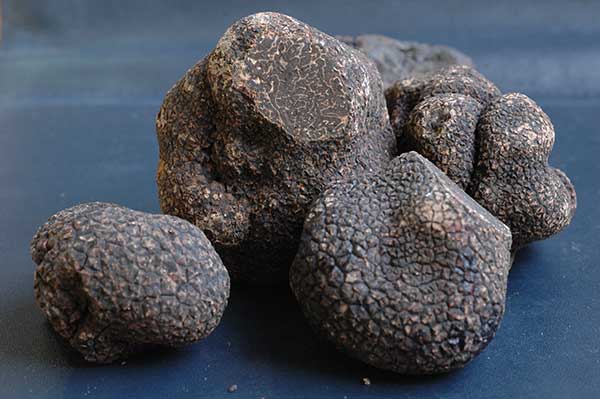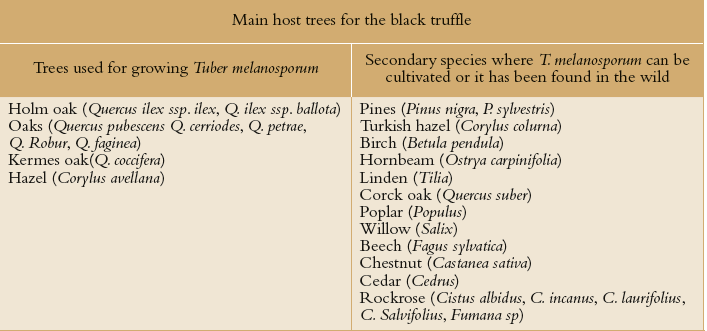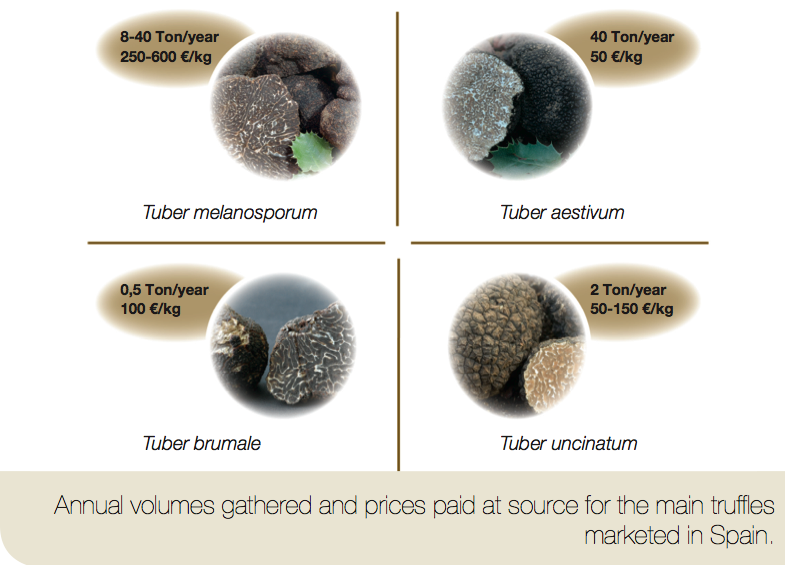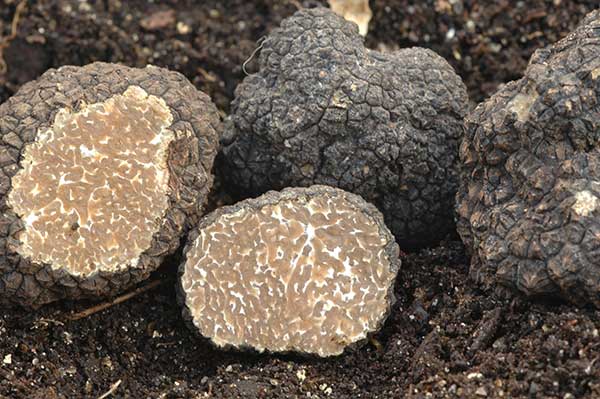Tuber
Melanosporum
(Black Truffle)
Ecology of truffières: Geographic,
geologic, and topographic
characteristics
The black truffle develops best on
natural limestone soils or those
amended to provide similar
conditions. Typically, inoculated
oaks such as Q. ilex, Q. ilex ssp.
rotundifolia, Q. faginea, or Q.
coccifera are planted in Europe.
In the United States, areas with
the most similar soil structure
and profile to these conditions
include areas within the Pacific
Northwest, the mid-Atlantic, and
the Southeast. However, pH may
need adjustment in many
regions of these areas. The
addition of pulverized limestone
to the soil accomplishes this.
Truffles appear naturally at
altitudes between 300 and 4500
feet above sea level. It is
advisable to choose orchard
sites with a slight slope to
avoid flooding that could occur
on flatlands and valley bottoms
(unless they have exceptional
drainage qualities). Equally
important, avoid steep slopes
where erosion might become
problematic.
Soil characteristics for the Black Truffle
Many parameters are important to consider
when planting truffières. For example, soil
texture, carbonate levels, iron levels,
magnesium levels, and levels of potassium
have great variability and impact on the
rhizosphere. To know if a soil can grow
truffles, the soil horizons should be first
of all, be analyzed to confirm the presence
of carbonates and measure the pH. Ideally,
the pH should be between 7.5-8.5 for
fruiting to occur. Truffle mycelium will grow
well in lower pH soils, but truffles will not
form or mature.
To check if the soil has carbonates, you can
send your soil to to test the soil with
effervescence. This is a process where diluted
hydrochloric acid reacts with the sample to
see if the soil boils.
As a final note on porosity, the soil should be
free draining, easily allowing water to drain
and air to access the roots. If this condition
is not met, truffles can be small as they
struggle to expand; truffles may rot when
water stands for long periods of time. There
are several options for correcting this issue,
such as deep ripping down a slope or
towards the nearest low-area.
Soil profile
In general, there should not be changes
between layers in the upper regions of the
soil. The structure should be uniform and
light. An ideal soil would have a crumbled
structure and spherical particles. Avoid
prismatic structures, and any signs of
nutrients leaching out, which indicates that
there will be trouble with the soil adequately
supporting plant life.
Soil consisting of a hard scale of organic
matter or rock will likely require adjustment.
More frequent ripping is necessary, or the r
esult is compacted soils or flooding.
Climate
Black and summer truffles are adapted to dry
and hot conditions, with well-differentiated
seasons, humid temperate, or cold sub-
humid Mediterranean climate. Hot and
humid springs, dry summers with some
storms, and no frost at the beginning of
autumn are also key features of their natural
environments. Yearly, accumulated rainfall
is generally between 17-50 in. (425-1270
mm). In cultivated orchards, comparable
amounts are targeted in total rainfall per
year, with supplemental irrigation.
Natural rainfall in the summer, when the
mycelium is active, is ideal. Precipitation of
2-3 in. (48-64 mm) monthly from June until
the end of August is best. If these conditions
do not occur naturally, it is beneficial to add
supplemental irrigation during the spring
and summer.
Previous crops
Previous crops and cover crops will condition
the soil with organic matter. Ideal crops
include cereals, legumes, and most fruit
trees, as they are endomycorrhizal.
Host plant selection
Black truffle grows in symbiosis with a wide
variety of plants (see next chart). In
cultivated orchards, few hosts are used.
Specifically, in Europe, around 90% of
plantations have Holm oak (Quercus ilex,
Quercus ilex ssp. rotundifolia), secondary
oaks (Quercus pubescens, Quercus faginea),
or hazel varieties (Corylus sp.). Generally,
avoid the Holm oak species (Quercus ilex var.
ilex) and English Oak (Quercus robur) if
possible. The reasoning behind this lies in
relation to the climate issues of Q. ilex var.
ilex, which is only reliably cold hardy to zones
8-10. The root overgrowth in Q. robur allows
competitive mycorrhiza to enter into the
orchard and leave less space for truffle
mycorrhiza on the root tips. Either way, using
these species can lead to unproductive or
damaged host trees. However, taking certain
steps can mitigate both issues, so if you
have already planted with these species
please contact us and we will recommend
corrective strategies.
On a similar note, planting with the European
Hazel (Corylus avellana) in the United States
generally leads to issues down the road.
Specifically, from Eastern Filbert Blight(EFB),
caused by the fungus Anisogramma
anomola. There are no immune varieties of
C. avellana in the market, only resistant
cultivars. European Hazels commonly get
infected with EFB. In this scenario, the
problem needs to be promptly addressed by
removing and burning affected limbs and
using a non-systemic fungicide, which could
still damage truffle mycelium. If possible,
select a species that does not get the blight,
such as C. colurna or an Oak. We are
currently trialing and assessing other
Corylus species and cultivars that are
unlikely to contract EFB.
Orchard Planting Density
We recommend planting densities between
175 to 225 trees per acre for the black
truffle. Less dense spacing is necessary
with deeper, richer soils with significant rain
-fall, as trees will grow faster and close the
canopy. Closed canopies can result in less
sunlight reaching the soil and warming the
mycelium, lowering total yields
unnecessarily. Using more trees per acre
allows more trees to fruit and a lower time
to wait for the production to start, but you
will have to prune more to avoid the
plantation canopy closing.
The density of your host trees is very
important when planting your truffière. If
your plant spacing is not adequate or too
wide for your climate and soil, your truffières’
yields can be severely diminished or
eliminated altogether. We recommend that
if you are unsure of how to proceed, you can
take advantage of our consulting services.
Customers of this service see reduced
stress and the insurance of professional,
timely orchard establishment optimized for
production.
Usually, plants are spaced at 18 ft.x18 ft. or
20 ft.×20 ft., but plants in the row can be
increased and the rows placed at a greater
distance (18 ft.×20 ft., 15 ft.×20 ft. or
12 ft.×30 ft.). In all cases, rows are planted
north to south, allowing sunlight to reach
the center of the entire row.
Soil management
When working the soil in preparation for
planting, orchard work must be done in the
summer and autumn months. Light tractors
are best used for plowing on dry soils. On
this note, avoid working after rainfall as soil
compaction results, hindering mycelium
growth. If your soil is favorable, but drainage
is not adequate, deeper plowing and/or sub-
soiling will break any compacted layers and
correct drainage. If possible, avoid mixing
soil layers, as this leads to a delay in your
truffières fruiting. As you may recall, the
importance of pH was previously mentioned.
To adjust pH, we recommend taking a slow
approach and neutralizing the soil over the
first several years of orchard establishment.
For cultivated truffles, the target pH for
fruiting is almost always between 7.5 to 8.5.
The Economics of Growing Truffles
In Spain, black and burgundy truffle-growing
areas have poor-quality limestone soils.
These soils were used for crops associated
with low agricultural performance, such as
cereal grains. Due to the low value of the
produce, farms were dependent on financial
aid for their survival. After the introduction of
mycorrhized truffle trees, growers do not
have to depend on subsidies, as their income
can triple. One specific area, Teruel, Spain,
has experienced an economic revival from
the truffle industry, with several large-scale
growers and many new hotels, restaurants,
and businesses resulting from the new
surge of wealth.
In Europe, it is estimated that some 30,000
families are involved in truffle growing and
truffle gathering, which accounts for 80-95%
of the world’s black truffle production. Very
few people now work exclusively as truffle
hunters. Most combine truffle hunting with
other work and/or do it during the weekend,
or even try to match their holidays with the
gathering season. In the United States,
truffières of a smaller scale are perfect for
supplemental income sources, where the
owners can tend the crop, or in larger
orchards with the resources to launch highly
productive and lucrative plantations as a
primary income source.
Price-wise, the value of black truffles in the
United States varies depending on whether
the season has been good or not (depending
on quantity and quality). As such, truffle
market values conform to traditional models,
where higher production can result in lower
prices. In the accompanying graphics, the
trends help visualize the behavior of the
truffle market, which is remarkably stable
despite cultivation.
Profitability of truffle farming
It is hard to determine the average production
of artificial plantations, as orchard
management practices are highly variable.
There are circumstances where a single tree
has been able to produce 25 lbs. of truffles,
while a plantation of oaks mycorrhized with
black truffle is capable of producing over 200
lb./acre/yr. This results in an annual potential
income of nearly $140,000 per acre (based
on the average U.S. Black Truffle price
deviation of $700-1200/lb.). However, we
can’t stress enough that this is only possible
with stellar orchard management; otherwise,
it is unlikely your orchard will produce even
25 lb./acre/yr. If interested in achieving these
yields, contact us about our research on
productivity additives and integrated
strategies proven to increase and simplify
production and management.
Some plantations have never produced for a
variety of reasons. Truffle farming as a
business is not without risks. In Europe, a
minimum production of 15-20 lb./acre/yr. is
required to recoup the initial investment
made in a plantation. In the United States
production must offset the initial costs of
liming and ripping to achieve ideal pH and
soil texture. However, do not be dissuaded by
this. Soils in the United States are generally
richer and able to produce higher yields than
the comparatively lower-quality soils found
in Spain and France.
Unfortunately, growers have discovered that
production begins to decrease after 50
years in many oak plantations. However,
there have been several truffle fields over
100 years old with brûlés over 20 ft. in
diameter and still in full production! New
technologies such as re-inoculation and bio-
stimulant bacteria can ensure production
well past 50 years.
 Tables comparing the
Tables comparing the
characteristics of soils that are
favourable and unfavourable for
truffle production. The favour-
able column lists some of the
characteristics that indicate
good drainage and aeration.
This data provides very useful
information for subsequent
working of the plantation.



 Annual volumes gathered and prices paid at source for the main truffles marketed in Spain. ●Tuber melanosporum - (8-40 Ton/year 250-600 €/kg). ● Tuber aestivum - (40 Ton/year 50 €/kg) ●Tuber brumale - (0.5 Ton/year 100 €/kg) ● Tuber uncinatum - 2 Ton/year 50-150 €/kg.
Annual volumes gathered and prices paid at source for the main truffles marketed in Spain. ●Tuber melanosporum - (8-40 Ton/year 250-600 €/kg). ● Tuber aestivum - (40 Ton/year 50 €/kg) ●Tuber brumale - (0.5 Ton/year 100 €/kg) ● Tuber uncinatum - 2 Ton/year 50-150 €/kg.
Annual volumes gathered and prices paid at source for the main truffles marketed in Spain.
.

Tuber Aestivum
(Burgundy/Summer truffle)
Tuber aestivum fruits in almost all European
countries; however, there are two varieties
of this truffle – the Summer truffle (Tuber
aestivum var. aestivum), and the Burgundy
truffle (T. aestivum var. uncinatum) which
only occurs in colder areas. Trees
mycorrhized with this species can produce
either subtype, or even both, depending on
the climate and soil.
Without touching on taxonomical controversy
regarding their classification, it is important
to note that both species are closely related.
They reveal minor differences at three levels.
1) In habitat, T. aestivum var. uncinatum is
found in colder areas with more organic soils.
2) In morphology, darker gleba and the
ornamentation of the spores are more
apparent in T. aestivum var. uncinatum
3) At the organoleptic levels, T. uncinatum
has a more pronounced taste and aroma. Of
course, reflected in the market price for the
two different varieties are these differences.
The wholesale range is typically between
$250 / lb. for T. aestivum and up to
$1200 / lb. for the best grade T. uncinatum.

Secondary species where T. aestivum can be
cultivated or it has been found in the wild:
Chestnut (Castanea sativa)
Oaks (Quercus coccifera, Q. peduculata,
Q. petraea, Q. pubescens, Q. sessiliflora)
Turkish hazel (Corylus colurna)
Hornbeam (Carpinus betulus, Ostrya
carpinifolia)
Pines (Pinus halepensis, P. pinea, P. Strobus)
Fir (Picea abies)
Cedar (Cedrus atlantica)
Pecan tree (Carya illinoinensis)
Rockroses (Cistus laurifolius, C. incanus)


No comments:
Post a Comment